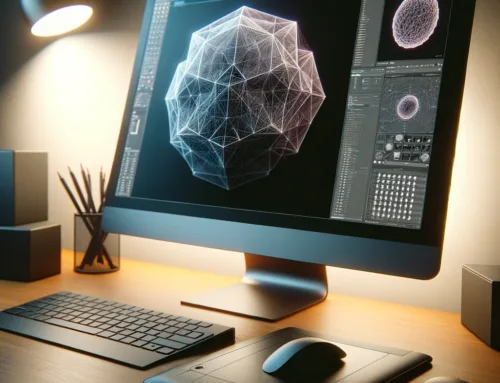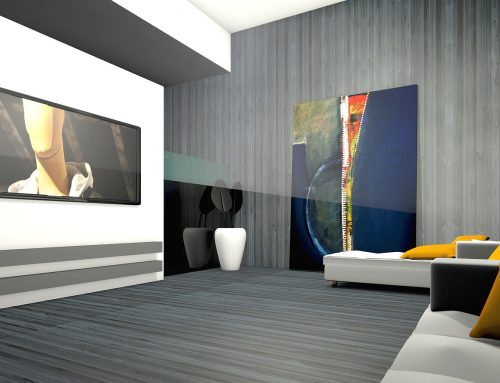Einsteigerguide: Cinema 4D 9.6 und Mograph.
In diesem Artikel beschäftigen wir uns intensiv mit Cinema 4D und dem MoGraph-Modul. Als Maxon es vor einiger Zeit auf der NAB vorstellte, waren alle begeistert und wir versuchen herauszufinden, ob es den Erwartungen der Nutzer entspricht.

Wir haben Cinema 4D in der Vergangenheit bereits von den Versionen 5.21 bis 8 verwendet, aber dann nach einer Weile aus internen Gründen aufgegeben. Mit diesem verblassten Wissen im Hinterkopf und ein paar Jahren, in denen wir das Programm zwischenzeitlich nicht verwendet haben, wollten wir es seit geraumer Zeit wieder in unser Arsenal aufnehmen. Wir haben seine Entwicklung ständig verfolgt und regelmäßig die Demoversionen heruntergeladen. Wir hatten schon immer ein großes Interesse an organischen Strukturen, die auf iterativer Mathematik basieren, also war xFrog ein Grund, weshalb wir Ausschau halten mussten und wir werden es sicherlich eines Tages kaufen. Darüber hinaus verfügt Cinema 4D über eines der vollständigsten und benutzerfreundlichsten Toolsets zur Erstellung von gemalten oder illustrationsähnlichen Szenen mit Hilfe von Sketch & Toon. Dies ist sowohl für die Grafikanimation als auch für unsere andere „ernsthafte“ Arbeit mit der technischen Visualisierung nützlich. Und als ob das noch nicht genug wäre, haben wir jetzt auch MoGraph.
Wir haben Cinema 4D jetzt wieder für 3 Wochen genutzt und es fühlt sich an wie in alten Zeiten. Es ergänzt unsere Arbeit so gut und obwohl wir es nicht für alle unsere Aufgaben verwenden werden, werden wir sicherlich viel Zeit damit verbringen.
Cinema 4D wächst weiter.
Bevor wir zum guten Teil übergehen, lassen Sie uns einen Blick auf Cinema 4D 9.6 werfen. Dieses Release ist hauptsächlich das, was andere Unternehmen als „Maintenance Release“ bezeichnen. Es rühmt sich nicht vieler neuer aufregender Funktionen, poliert aber das mit 9.5 eingeführte Material und konzentriert sich auf die Erweiterung der zugrunde liegenden technischen Prozesse (der Kern des Programms), um es für die zukünftige Entwicklung zu öffnen. MoGraph ist ein solches Modul, dass bereits von den Verbesserungen profitiert.
Eine weitere willkommene Ergänzung ist die Einführung eines „unterteilten“ Modus für Splines. Technisch gesehen berechnet dies mehr Zwischenpunkte pro Kraft und führt zu sauberen Modellen, wenn Sie z.B. ein Extrude NURBS-Objekt in Kombination mit Deformer verwenden. Anders als in der Vergangenheit werden ihre Mützengesichter nicht verrückt und brechen nicht ab. Damit wird der Einsatz von Deformern in Bereichen, in denen man sie in der Vergangenheit entweder aus den genannten Gründen nicht verwendet hat, der nur mit stark unterteilter polygonaler Geometrie verwenden konnte, neu belebt.
Dieses Release ist für uns Motion Graphics und Compositing Heads, daran besteht kein Zweifel. Dies wird durch einige zusätzliche Funktionalitäten für diese Art von Arbeit zusätzlich unterstrichen. Zunächst möchten wir die Unterstützung für eine weitere Compositing-Anwendung erwähnen – Eyeone`s Fusion 5. Wenn Sie diese Option wählen, schreibt Cinema 4D eine *.comp-Datei für Sie aus. In die gleiche Kategorie fällt das neue External Compositing Tag. So können Sie auf einfache Weise jedes Objekt als Platzhalter für eine 3D-Ebene z.B. in After Effects markieren. In der Vergangenheit mussten Sie dafür Lichter als Workaround verwenden. Relevant für das Rendern sind die nächsten beiden Elemente: Das Compositing-Tag enthält nun die Option, jedes Objekt, auf das es angewendet wird, als Matte-Objekt zu kennzeichnen, wodurch es einfach ist, benutzerdefinierte Matte-Renderings aus einer Szene zu erstellen, ohne neue Materialien für einen RGB-Mattpass anwenden zu müssen. Schließlich ist es nun möglich, Bewegungsfaktoren auszugeben, die mit dem beliebtesten Motion-Blur-Filter ihres Compositing-Tools verwendet werden können.
Was ist in der Box?
MoGraph wird auf einer DVD geliefert, die ein First-Timer rund um Cinema 4D ist. Dies geschieht vor allem aufgrund der enthaltenen lizenzfreien Musik. Auf der Diskette finden Sie auch den Installer für das Update 9.6 sowie natürlich den Installer für MoGraph. Die Dokumentation ist als PDF-Datei enthalten und es werden einige zusätzliche Demo-Szenen bereitgestellt. Das ist so ziemlich alles.
Tools in Hülle und Fülle.
Cloner, Matrix, Instanz.
Um das zu erzeugen, was wir normalerweise als „strukturiertes Rauschen“ bezeichnen, braucht man natürlich viele Elemente, die dieses Rauschen ausmachen. Die Objekte Cloner, Matrix und Instanz sorgen dafür, dass dies alles auf ihre eigene Art und Weise geschieht. Während einige Leute sagen würden, dass diese das Herzstück von MoGraph sind, kann das nicht weiter von der Wahrheit entfernt sein. Tatsächlich arbeiten diese Tools alle für sich allein, sind aber in Kombination mit Effektoren viel schöner. Betrachten wir sie etwas detaillierter.
Der Cloner wird die Waffe der Wahl für Sie sein. Wie der Name schon sagt, nimmt es jedes Objekt (oder mehrere Objekte), das in es fallen gelassen wird und ordnet es auf verschiedene Weise an. Eingebaut sind einfache Modi wir linear, radial oder Raster, aber wenn Sie es ernst meinen, werden Sie feststellen, dass der Objektmodus in vielen Situationen unvermeidlich ist. Dadurch können Sie ihre Klone entlang einer Spline oder entlang der Oberfläche eines anderen Objekts anordnen und noch mehr Kontrolle erhalten. Zusätzlich zur Anordnung ihrer Gegenstände ändert der Kloner diese auch anhand einer Reihe von Parametern. Die Macht endet jedoch nicht damit. Dank des parametrischen Ansatzes von Cinema 4D können Sie einen Kloner in einen Kloner fallen lassen und so Klone einer bereits geklonten Struktur erstellen. Sie können dieses Konzept durchaus erweitern, aber natürlich werden Sie an einem bestimmten Punkt am Ende so viele Klone haben, dass es ihrem System schwer fallen wird, Schritt zu halten.
Das Matrix-Objekt bietet eine ähnliche Funktionalität wie der Kloner, wird aber etwas anders behandelt. Ein kleiner Nachteil des Kloners ist, dass das Kino seine Hierarchie als zusammengesetztes Objekt behandelt. Dies kann zu unerwünschten Verzerrungen der Klone führen, wenn Sie z.B. Deformerobjekte in Kombination mit einem solchen Setup verwenden. Wie der Name schon sagt, stellt das Matrixobjekt nur eine mathematische Matrix zur Verfügung, die die Objekte anordnen kann, aber ihre Form intakt lässt.
Das letzte der drei ist das Instanzobjekt. Es wird eine Spur von Animationszuständen eines Objekts erstellt. Das klingt zunächst interessant, aber leider ist die Kontrolle sehr begrenzt, so dass Sie dieses Tool vielleicht nicht allzu oft verwenden.
Effektoren.
Effektoren sind ihre besten Freunde bei der Kontrolle all dieser Horden von Klonen und sie hängen auch an einigen der anderen Tools. Teilweise können sie die in den Klonern vorgenommenen Einstellungen überschreiben, aber häufiger ändern Sie sie einfach weiter nach anderen Kriterien. Dies kann alles sein, von einer einfachen Zufälligkeit bis hin zur Steuerung ihrer Klone basierend auf Sounds, um ihnen jeweils einzigartige Shading-Eigenschaften zu verleihen. Es gibt buchstäblich unendliche Kombinationen und es wäre unmöglich, sie alle abzudecken. Deshlab sollten Sie auf dem Laufenden bleiben, wenn wir sie in den Videos im Detail durchgehen werden. Lassen Sie uns diese hier nur kurz der Vollständigkeits halber auflisten.
Zufällig: Parameter variieren zufällig.
Schritt: Erstellen von Treppenstufen oder gemischten Varianten.
Spline: Klone auf Spline-Formen beschränken
Formel: Kontrollklone basierend auf mathematischen Formeln
Ziel: Zielklone auf ein Zielobjekt
Vererbung: Imitiert das Verhalten eines „Master“-Objekts
Verzögerung: Animieren Sie Klone mit einem zeitlichen Falloff.
Zeit: Automatisches Animieren von Variationen im Laufe der Zeit
Gruppe: Synchronisieren Sie mehrere Effektoren ohne zusätzliche Keyframes
Shader: Verwenden Sie Texturen und Materialien, um Klone zu kontrollieren
Sound: Antriebseffekte basierend auf Audiodateien.
Tracer.
Das Tracer-Objekt ist eine Möglichkeit, vollständig animierbare Spline-Pfade in großer Anzahl zu erstellen, indem Objekte oder Nodes verfolgt werden. Dadurch entfällt die Notwendigkeit, PLA zu verwenden, was sehr mühsam wäre, um mehr als nur ein paar Splines einzurichten. Da die gesamte Animation von anderen Objekten abgeleitet ist, erleichtert sie auch Dinge wie die Animation von baumelnden Schläuchen und Seilen.
Text-Objekt.
Auf den ersten Blick mag es für MoGraph überflüssig erscheinen, ein eigenes Textobjekt einzuführen, da Cinema 4D bereits ein parametrisches spline-basiertes Textobjekt hat, aber das hat natürlich seinen Grund. Am wichtigsten ist, dass es auf Effektoren reagieren kann, was das alte Textobjekt nicht kann. Dies gibt ihnen die Möglichkeit, jeden Buchstaben, jedes Wort oder ganze Textzeilen in einer Weise zu beeinflussen, die den Textanimatoren von After Effects ähnelt. Zweitens verfügt es auch über integrierte Optionen für Extrusionen, Kappen und Verrundungen, wodurch es einfach ist, 3D Text zu erstellen, ohne eine Hierarchie von Objekten erstellen zu müssen.
Spline Wrap, Displace, Extrude und Fracture Objekt.
Diese drei stellen Verformungsobjekte dar, die MoGraph ergänzen. Es gibt ähnliche Tools von Drittanbietern, entweder kostenlos oder als Teil kommerzieller Pakete, aber bis jetzt hatte Cinema 4D diese Funktionen noch nicht aktiv. Da es sich um Deformatoren handelt, können sie auch Kloner und alle andere MoGraph-Werkzeuge sowie alle anderen Objekttypen betreffen.
Spline Wrap verformt Objekte entlang einer Spline, ähnlich wie eine Schlange. Das klingt langweilig und ist sicherlich nicht so aufregend, aber es ist ziemlich nützlich und man kann sich nur fragen, warum es schon lange nicht mehr im Basispaket enthalten ist.
Ein weiteres solches Tool, das im Arsenal seit langem fehlt, ist der Displace-Deformer. Abgesehen davon, dass es eine sehr allgemeine Möglichkeit bietet, ihre Objekte mit Shadern und Materialien unter voller Berücksichtigung ihrer Projektions-/Mapping-Modi zu verformen, ist das Tolle an diesem Tool, dass Sie z.B. Klone auf einer animierten Oberfläche tanzen lassen können, da es animierte Texturen jeglicher Art vollständig unterstützt.
Das vielleicht exotischte Werkzeug des gesamten Pakets ist Extrude. Es funktioniert ähnlich wie die klassische Matrix-Extrusion, bleibt aber vollständig editierbar. Für noch mehr Kontrolle kann er sogar an Splines als Guide angeschlossen werden. Dies macht es zu einer idealen Wahl, um verschiedene „Kritzeleien“ für Hintergrundelemente wie Neuronenpfade, Pelzbälle, zufällige Spikes und andere außerirdisch aussehende Dinge zu erstellen.
Schließlich gibt es noch das Fracture-Objekt. Es funktioniert ähnlich wie die Deformer Shatter, Explosion oder Explosion FX, kann aber von den Effektoren beeinflusst werden. Es wird auch darauf geachtet, zusammenhängende verbundene Objekte zu erhalten, anstatt ihre Objekte zufällig in kleinere Stücke zu „zerkleinern“. Benutzer von After Effects werden dieses Verfahren kennen, wenn Sie beispielsweise den Effekt Shatter in Kombination mit einer Vektorgrafik verwenden, die kontinuierlich gerastert und eingeschaltet ist.
Shader.
MoGraph wird mit 3 Shadern geliefert, die jeweils auf die jeweilige Anwendung zugeschnitten sind. Der einfachste von ihnen ist der Color Shader. Der Hauptzweck ist es, ihnen Zugang zu den Farbvariationen zu geben, die Sie mit Effektoren und Clonern definieren können und diese Informationen in jedem Materialkanal und nicht nur in der Farbe zu verwenden.
Als nächstes steht der Multishader auf der Liste. Im Gegensatz zum Color Shader variiert dieser nicht nur einzelne Materialkanäle, sondern ganz Materialien. Wenn Sie also beispielsweise drei verschiedene Materialien in den Multishader fallen lassen und ihn einem Effektor zuweisen, können Sie auf jedem Klon unterschiedliche Texturen haben, ohne vorher verschiedene Klonelemente zu erstellen. Dies ist besonders praktisch, wenn Sie sich in einer experimentiellen Phase befinden und sich noch nicht für ihren endgültigen Look entschieden haben.
Der letzte Shader ist der Beat-Shader – wie der Name schon sagt, erzeugt dieser zyklische „Beats“, wie sie oft in einem Musikstück oder auf blinkenden Displays a la „Star trek“ vorkommen.
Spline-Maske.
Dieses spezielle Tool passt nicht wirklich in eine Kategorie mit den anderen und seine Bezeichnung ist auch etwas irreführend. Es maskiert nicht wirklich etwas, sondern ist ein Mittel, um Booleans mit Splines zu erstellen. Dadurch entfällt nicht nur die Notwendigkeit, ihre Vektorgrafiken in externen Programmen wie Illustrator vorzubereiten, sondern da jedes Spline-Element separat bleibt, können Sie sie interaktiv in Cinema 4D bearbeiten und sogar animieren.
XPresso Nodes.
Um die Sache zu vervollständigen, bringt MoGraph seine eigenen Nodes für den Zugriff auf seine internen Datenstrukturen mit. Wenn Sie also einer dieser XPresso-Genies sind, können Sie ihre eigenen verrückten Setups erstellen, indem Sie diese Daten verwenden.
Wie Sie sehen können, ist die Erweiterung der Funktionalität, die MoGraph in Cinema 4D bietet, recht umfangreich und beeindruckend. Dies gilt umso mehr, als es in Bereichen hinzukommt, die nicht nur den Grafikanimatoren zugute kommen, sondern auch viele andere gängige Aufgaben erleichtern können. Der Tracer, Displace und Spline Wrap sind gute Beispiele dafür und können die Investition allein in Situationen wert sein, in denen Sie keine anderen Werkzeuge verwenden können, um ihre Ergebnisse zu erzielen. Es ist auch bereits teilweise mit anderen Modulen wie Thinking Particles integriert, was ihnen noch mehr Möglichkeiten bietet.
Mograph ist nicht Jenna und Jenna ist nicht DiTools.
Es wird derzeit darüber diskutiert, was Maxon zur Herstellung von MoGraph motiviert hat und wie der Fit des Toolsets mit dem aktuellen Markt aussieht. Obwohl wir keine tieferen Einblicke geben können, vor allem weil wir nur die Demoversionen dieser Tools verwendet haben, lassen Sie mich ihnen trotzdem meine Ansichten darlegen.
Cinema 4D ist seit geraumer Zeit sehr „motiongraphickly“. Dafür gibt es mehrere Gründe, sei es die Einfachheit der Erstellung von 3D-Text und Logos (weil die Spline-Tools einfach funktionieren), die Leichtigkeit bei der Erstellung einer großen Anzahl von Objekten oder flexiblen Deformern. Sogar der schneller Renderer konnte dazu gerechnet werden. Diese Tendenz wurde noch deutlicher, als das Multipass-System und der Export von After-Effects-Kompositionen eingeführt wurden. Nach dieser Entwicklung scheint MoGraph der nächste logische Schritt zu sein.
Dann gibt es noch die andere Seite. DiTools und JENNA sind beide Toolsets, die viele Funktionen ähnlich wie MoGraph bieten. Beide haben auch einige Probleme, die nicht unter den Teppich umgekehrt werden können. Wie Sie vielleicht wissen, ist JENNA nicht mehr verfügbar. Da die Entwicklung eingestellt ist, konnte man sie nicht mit den Umfang an Funktionen kaufen, die man wollte. Es gibt keine Garantie, dass es mit zukünftigen Versionen von Cinema 4D funktioniert. Was DiTools betrifft besteht das größte Problem darin, dass es an einer ordentlichen Dokumentation fehlt. Selbst nachdem wir es gründlich studiert hatten, konnten wir einige Funktionen nicht verstehen. Darüber hinaus scheint die Entwicklung eher sporadisch zu sein, da sich der Entwickler nun auf PhyTools zu konzentrieren scheint.
Wäre es für Maxon nicht logisch, ein Tool wie MoGraph anzubieten? Wir denken schon. Es gibt ein gewisses Maß an Sicherheit für die Zukunft, da es unwahrscheinlich ist, dass das Unternehmen, das das Hauptprogramm erstellt, möglicherweise eines seiner Module entsorgt. Als Seite wissen Sie wirklich, an wen Sie sich wenden können, wenn Sie ein Problem haben oder ein Feature anfordern möchten. Schließlich gehörte die Dokumentation von Maxon schon immer zu den besseren in der Branche, was natürlich sehr hilfreich ist. Doch wo Licht ist, ist immer auch Schatten. In diesem Fall halten sich die negativen Aspekte stark in Grenzen, aber dennoch sind die kleinen Hürden, auf die Sie treffen werden, ummer noch wert erwähnt zu werden.
Dinge, die wir vermisst und die uns nicht gefallen haben.
Auf die Gefahr hin, uns selbst zu widersprechen, fehlt MoGraph die Dokumentation. Wir denken, dass es etwas mit seiner Tiefgründigkeit zu tun hat und während das Handbuch ihnen die technischen Grundlagen erklärt und in dieser Hinsicht gut gemacht und illustriert ist, verpasst es, ihnen Hinweise auf ihre praktische Anwendung in der täglichen Arbeit zu geben. Wir glauben wirklich, dass eine Art Tutorial-Leitfaden benötigt wird, idealerweise als Trainings-DVD.
Außerdem fehlen einige anständige Beispielszenen. Die wenigen Beispielszenen, die zur Verfügung gestellt werden, werden MoGraph nicht nur gerecht, sondern sind auch nicht sehr durchdacht zusammengestellt. Wir waren wirklich enttäuscht und verärgert, eine Warnung über fehlende Plugins zu erhalten, nur weil wir keinen Advanced Renderer oder Speicherpfade, die versuchen, in nicht existierende Verzeichnisse zu schreiben, sowie Szenen, die beim Öffnen aus dem Contentbrowser automatisch abgespielt werden. Dies ist nicht „professionell“ von einem kommerziellen Produkt. Unser allgemeiner Eindruck ist, dass dieser Aspekt überstürzt wurde und diese Ärgernisse hätten vermieden werden können.
Da Maxon dies als großes Feature verkauft, lassen Sie uns einen Blick auf die Musik werfen oder genauer gesagt, ein Ohr dafür haben. Die meisten Stücke sind von der elektronischen Art. Von House bis hin zu aggressiven Techno-Sounds findet man alles. Es gibt keine Tiefe und Finesse und alles klingt eher uninspiriert wie die vielen CD-Kollektionen mit „lizenzfreier, filmreifer Musik“, wie wir sie alle hin und wieder benutzt haben, als wir keine andere Wahl hatten. Verstehen Sie uns nicht falsch, es ist keine schlechte Sache, wenn Sie nur herumspielen möchten und keine spezifischen Bedürfnisse haben und außerdem bekommen Sie die Loops der Stücke, um ihre eigenen Tracks zu mischen, aber wir denken nicht, dass es notwendig gewesen wäre, da wir in einer Produktionssituation woanders nach besserem Material gesucht hätten.
Nun zur technischen Seite der Dinge. Mit JENNA und DiTools als Inspiration waren wir überrascht, dass einige ihrer nützlicheren Funktionen in MoGraph nicht implementiert wurden. Von besonderer Bedeutung sind JENNAs Daten-Tag und NICKL oder einige der verrückten, aber nützlichen Deformer von DiTools. Wir stellten auch fest, dass einige der Funktionen in diesen beiden Tools einfacher und im Einklang mit den allgemeinen Paradigmen des Kinos implementiert sind. Beispielsweise müssen Sie in MoGraph zu oft Objekte ziehen, um Felder zu verknüpfen, anstatt sie einfach in eine Hierarchie zu platzieren, wie Sie es bei den anderen beiden Werkzeugen tun. Das ist natürlich nur ein kleines Problem, aber wir denken, es hätte an einigen Stellen elegantere Lösungen geben können.
Ein Problem, das nicht zu unserer Zufriedenheit gelöst wurde und viel Frustration verursacht, ist der Shading- und Texturierungsteil. Es handelt sich um eine Menge Hit & Miss, zumal es in vielen Fällen nicht ganz klar ist, wie MoGraph Farben basierend auf der ID des Klons zuordnet. Wir geben zu, dass einige Probleme auf unsere mangelnde Erfahrung mit Cinema 4D zurückzuführen sind, aber es fühlt sich sicherlich seltsam an.
Was könnte auch enthalten sein?
In dem folgenden Abschnitt möchten wir auf Dinge eingehen, die uns gefehlt haben.
Einfach und unkompliziert zu bedienende Shader, die es ermöglichen, mehrere Shading-Eigenschaften zu optimieren, ohne jedem Kanal einen MoGraph Color Shader zuweisen zu müssen und ein anderer, der eine zufällige Wiedergabe von Bildsequenzen ermöglicht, ohne die Einfachheit der Einrichtung zu zerstören, wäre ein guter Ausgangspunkt gewesen. Die aktuelle „To Layer“-Funktion im Multishader funktioniert zwar, ist aber für diese Art von Setup sehr unangenehm zu verwenden.
Eine weitere Angelegenheit, die Aufmerksamkeit erfordert, ist ein wenig mehr Kohärenz im allgemeinen Verhalten. Alles Effektoren müssen zum Beispiel mit jedem Werkzeug arbeiten. Selbst die Kloner akzeptieren nicht alle Parameter von einigen Effektoren, was die Einrichtung oft komplizierter macht als nötig, Andere Tools wie der Tracer können überhaupt keine Effektoren verwenden. Dies ist nicht sehr logisch und etwas unkonsequent umgesetzt.
Maxon sollte sich auch die Zeit nehmen, das Verformungsteil zu erweitern. Einer unserer Hauptgriffe ist hier, dass der Spline Wrap Deformer zwar in vielen Situationen super ist, aber nicht mit Klonern und Effektoren kombiniert werden kann, was seinen Nutzen unnötig einschränkt. Ähnliche Einschränkungen gelten für andere Verformungswerkzeuge, vor allem, weil sie oft keine Ahnung haben, wie ein Kloner platziert, gedreht oder skaliert werden soll.
Schließlich muss es eine Möglichkeit geben, mit vielen, vielen Objekten effizienter umzugehen. Das Rendern von Szenen mit Hunderten von Klonern kann sehr langsam sein, da sie auch die Szene-Dateien selbst bearbeiten können. Einige anständige Instanzen würden den Workflow erheblich verbessern. Wir konnten einige unserer Setups nicht rendern, weil sie so viele Klone enthielten, dass es ewig dauerte, bis sogar Schatten von einer einzigen Lichtquelle berechnet wurden. Dabei geht es nicht einmal darum, wie man mit Hyper NURBS-Objekten und anderen Effekten, die noch mehr Polygone erzeugen, den Renderer töten kann.
Abschließende Gedanken.
Abgesehen von kleinen Problemen und Beschwerden ist MoGraph dennoch ein fantastisches und leistungsfähiges Tool. Es ist eins im Einklang mit dem kürzlich veröffentlichten Hair-Modul und wenn Maxon die Entwicklung in diesem Tempo fortsetzt, können wir in Zukunft große Dinge und viele weitere Überraschungen erwarten. Wo andere zögern oder sich auf andere Zielgruppen konzentrieren, weiß Maxon, wie man seine Benutzer glücklich macht. Das Ziel aller Bemühungen mit MoGraph muss es nun sein, es noch ein wenig zu polieren und einige seiner Grenzen zu überwinden und wir sind uns sicher, dass die Entwickler hart daran arbeiten werden. Vor diesem Hintergrund können wir MoGraph nur jedem angehenden Motion-Grafiker empfehlen.
Während das meisten von dem, was MoGraph leistet, sicherlich auch mit anderen Tools umgesetzt werden kann, war es noch nie so einfach. Wir sind immer noch fasziniert wie schnell die Zeit vergeht, wenn wir mit all diesen Klonern, Effektoren und anderen Tools arbeiten, weil es einfach große Freude bereitet.
Falls noch Fragen offen geblieben sein sollten, können Sie sich gerne über unser Forum an unsere Fachexperten wenden.
Vielen Dank für ihren Besuch.


